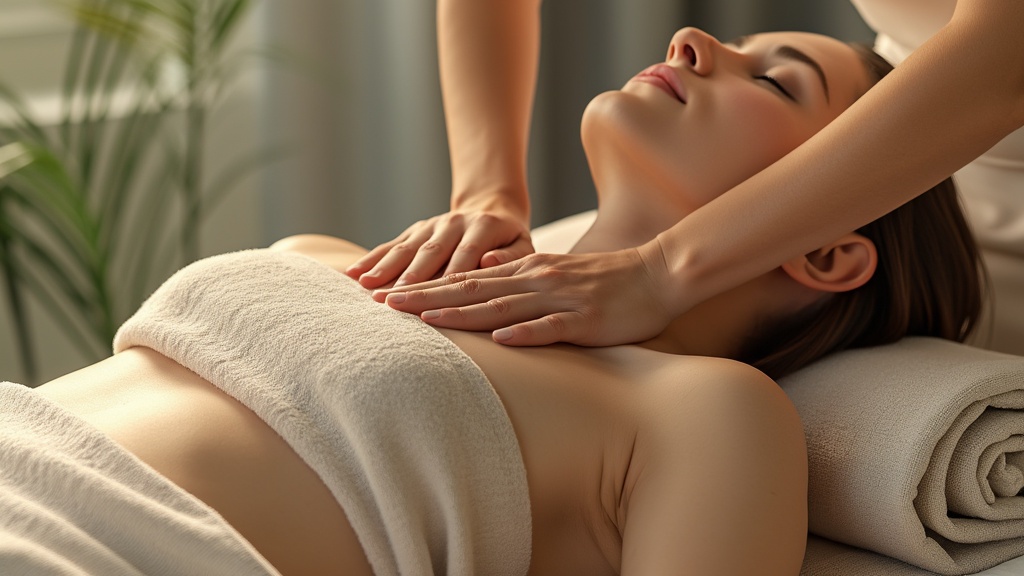
Myofascial release serves as an effective manual therapy technique aimed at alleviating pain. This treatment targets the fascia, promoting chronic pain relief and restoring functionality.
Myofascial release enhances soft tissue manipulation, reducing muscle stiffness and improving mobility.
Patients often experience significant tension reduction and increased flexibility.
Whether dealing with acute or chronic conditions, myofascial release can yield transformative results. By addressing underlying muscular issues, individuals report improved posture and overall well-being.
This therapeutic approach not only alleviates discomfort but also fosters a more active lifestyle, making it a valuable tool for pain management.
Understanding Myofascial Techniques Benefits
Evaluation of myofascial techniques reveals significant impacts on overall wellness, linking closely to holistic therapy. These techniques address both physical and mental health aspects, creating a comprehensive approach to pain management.
Myofascial techniques prioritize muscle relaxation and promote stress relief, making them effective for various patients.
One common myofascial technique is trigger point therapy, which targets specific areas of tension in the body.
This method improves circulation and releases adhesions, facilitating recovery and enhancing range of motion. Ultimately, incorporating myofascial techniques into treatment plans can lead to improved long-term health outcomes.

How Does Manual Therapy Help?
Manual therapy significantly influences muscle tension by promoting relaxation and alleviating stress hormones. This bodywork approach enhances blood flow and oxygenation to tissues, which is essential for muscle recovery.
Different styles of manual therapy, such as myofascial release, specifically target fascia, offering benefits like pain relief and flexibility improvement.
Chiropractic adjustments focus on spine alignment, which aids recovery, while sports massage enhances athletic performance and muscle recovery.
For at-home relief, practitioners can try a simple self-massage technique known as The Palm Press, where gentle pressure is applied to tense muscle areas.
Chronic Pain Relief Through Fascia Release
Fascia release methods effectively address chronic pain management strategies that have been previously highlighted. Common conditions such as fibromyalgia and sciatica benefit significantly from these techniques, providing targeted relief.
By improving circulation, fascia release enhances blood flow, promoting healing while reducing inflammation. Increased mobility from these techniques contributes to functional movement, allowing individuals to engage in daily activities more effectively.
A practical example of a fascia release exercise is foam rolling, which involves using a foam roller to target tight fascia along the spine and legs, thus aiding in recovery and overall well-being.
Manual Therapy and Fascia Release
- Manual therapy can reduce muscle tension by promoting relaxation and decreasing stress hormones.
- Studies show that myofascial release can lead to improved flexibility and pain relief in patients.
- Chiropractic adjustments have been linked to enhanced recovery and better spine alignment.
- Foam rolling is an effective self-care technique for targeting tight fascia and improving overall mobility.
Enhancing Mobility Improvement With Bodywork
Achieving improved mobility requires a multifaceted approach that can be significantly enhanced through bodywork. Bodywork techniques, such as therapeutic touch and myofascial release, effectively address specific mobility issues by targeting restrictions in the fascia and soft tissues.
Consistency in these practices is essential; regular sessions can lead to substantial gains in mobility and flexibility.
For optimal results, consider integrating bodywork into your fitness routine by scheduling biweekly sessions.
This approach not only aids in chronic pain relief but also supports physical therapy, establishing it as a complementary strategy for overall mobility improvement.
The Role of Bodywork Techniques
Various bodywork techniques provide therapeutic benefits that enhance mobility, such as:.
- Soft tissue manipulation to alleviate muscle stiffness and improve range of motion.
- Trigger point therapy to decrease tension and promote relaxation.
- Connection to physical therapy for a holistic approach to rehabilitation.
Incorporating Bodywork into Fitness Routines
Incorporating bodywork into regular fitness routines can significantly advance mobility improvement. Schedule biweekly sessions, and prioritize consistency to see tangible results. This integration not only fosters wellness practices but also enhances your overall fitness experience.
Sports Therapy And Muscle Relaxation Insights
Engaging in sports therapy techniques significantly contributes to injury prevention and athletic performance enhancement. Various sports therapy modalities focus on muscle relaxation, which is integral for optimal performance. Techniques such as manual therapy and neuromuscular therapy provide effective solutions for reducing tension and improving circulation.
Benefits of Muscle Relaxation in Performance
Muscle relaxation plays a vital role in athletic performance, as it helps:.
- Enhance flexibility improvement and range of motion.
- Facilitate athletic recovery and lower the risk of injuries.
- Support stress relief and overall well-being.
Routine for Muscle Recovery Post-Workout
A structured routine for muscle recovery after intense workouts should include:.
- Gentle stretches to maintain flexibility.
- Relaxation techniques to ease tension and promote recovery.
- Therapeutic exercises aimed at reinforcing strength and stability.
This approach contributes to overall physical restoration and peak performance, encouraging a balanced and effective fitness regimen.
Bodywork and Mobility
- Regular bodywork sessions can lead to a 30% increase in overall mobility and flexibility.
- Studies show that therapeutic touch can reduce chronic pain by up to 50% in some individuals.
- Integrating bodywork with physical therapy can enhance recovery time by 20%.
- Muscle relaxation techniques can improve athletic performance by increasing range of motion by 15%.
What Role Does Therapeutic Touch Play
Therapeutic touch represents a significant component of energy healing, facilitating emotional and physical balance. This gentle practice involves the intentional placement of hands on or near the body, which not only aligns energies but also encourages relaxation.
By reducing stress levels, therapeutic touch can effectively lower cortisol production, fostering a profound sense of well-being.
Research indicates that therapeutic touch can enhance mood and alleviate feelings of anxiety.
For instance, a simple act of placing a hand on a friend’s shoulder during a conversation can create emotional support, fostering deeper connections while respecting personal boundaries.
Posture Correction Via Myofascial Release
Effective posture correction plays a vital role in overall health, significantly influencing both physical alignment and mental well-being. Myofascial release techniques, including foam rolling and soft tissue manipulation, specifically target tension in fascia, which contributes to chronic pain relief and flexibility improvement.
These methods help release tightness, allowing for enhanced movement and comfort.
To maintain awareness of good posture, consider setting reminders throughout your day to check your body position while sitting or standing.
Integrating brief stretching sessions can further enhance your posture correction efforts and support long-term physical health.
| Therapeutic Touch Benefits | Myofascial Release Techniques |
|---|---|
| Reduces cortisol production | Targets tension in fascia |
| Enhances mood and alleviates anxiety | Improves flexibility and chronic pain relief |
| Encourages relaxation | Supports long-term physical health |
Exploring Pain Reduction Strategies Effectively
Effective pain reduction strategies play a significant role in comprehensive pain management. Understanding various techniques can empower individuals to manage discomfort more efficiently.
Lifestyle changes, such as regular exercise and balanced nutrition, are essential components in this process.
Incorporating Lifestyle Changes
Regular exercise promotes muscle relaxation, which can lead to greater mobility improvement and tension reduction.
Engaging in physical activities tailored to individual needs enhances flexibility improvement and overall health. Balanced nutrition can significantly impact chronic pain relief by providing necessary nutrients to support bodily functions.
The Role of Mindfulness and Relaxation
Mindfulness practices, including relaxation techniques, significantly contribute to pain relief by promoting stress relief and enhancing overall well-being.
Techniques such as deep breathing, meditation, and yoga can help individuals become more aware of their body sensations and improve their emotional response to pain. Integrating these practices into daily routines facilitates better body awareness and therapeutic benefits.
Utilizing a Pain Journal
To track the effectiveness of these strategies, maintaining a pain journal can be incredibly beneficial.
This tool assists individuals in recognizing patterns related to pain triggers and responses.
By documenting the implementation of various pain reduction strategies, such as therapeutic exercises and gentle pressure techniques, one can identify what works best for their unique situation, ultimately leading to improved pain management outcomes.
Pain Reduction Strategies
- Regular exercise can reduce chronic pain by up to 30% according to various studies.
- Mindfulness practices have been shown to decrease pain perception and improve emotional regulation in individuals suffering from chronic pain.
- Keeping a pain journal can help individuals identify triggers and patterns, leading to more effective pain management strategies.
- Balanced nutrition plays a crucial role in reducing inflammation, which can alleviate chronic pain symptoms.
